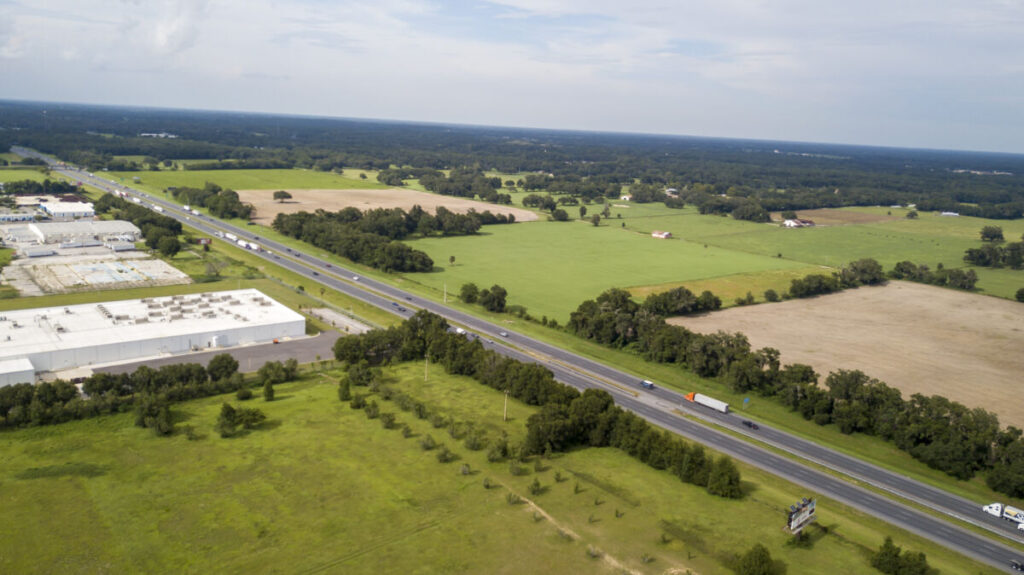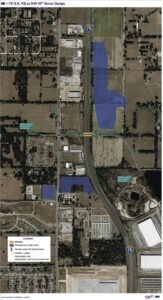The price of Buc-ee’s
How the future world’s largest Buc-ee’s and the Interstate 75 interchange impact farmland

Land on the east side of I-75, shown on the right, is the area where the new Buc-ee’s will be built along with the 49th Street off ramp. It is shown Tuesday, July 25, 2023, in Ocala, [Alan Youngblood/Special to the Ocala Gazette].
When a longtime cattle-ranching family heard about a potential new interchange at Interstate 75 and Northwest 49th Street in Marion County over a decade ago, they feared the coming construction would involve land that had been in their family for nearly 70 years.
Now, as plans for the new interchange are taking shape, those fears are becoming reality.
Joy Baldwin Papy of Baldwin Angus Ranch said the family quickly realized the proposed location of the project would lop a large portion of their ranchland off from the rest, rendering it inaccessible after decades of the family raising prized Angus beef cattle on their northwest Marion County property.
“It’ll be landlocked away from us with all the roads that they’re putting in,’’ said Papy’s niece Christine Damron. “So, we wouldn’t be able to run cattle over there, we wouldn’t be able to get tractors over there to lease the property for peanut farming or anything like that.”
That corner of the Baldwins’ property happened to be an ideal location for a travel center as part of the new I-75 interchange. So, when the popular travel center chain Buc-ee’s took interest in their land back in 2020, the family decided they would make the best out of a difficult situation and in April of this year sold about 35 acres of the land they cherished.
The $8.6 million that Buc-ee’s paid for the land allowed the family to buy more land that connects to the northeast side of their property, Papy said. At the ranch’s largest, it spanned about 640 acres. These days, the members of the Baldwin family own less than 600.
Now, the Baldwins might have to part with upward of 100 additional acres as part of the project. The Florida Department of Transportation (FDOT) has proposed building a retention pond north of the interchange and east of I-75, on top of even more of the Baldwins’ land, Papy said.
This time, they likely won’t be able to replace that land because there isn’t much farmland left to buy, she said.
None of the Baldwins’ land has been bought yet for the interchange, roads or potential retention pond, but the family fears it is inevitable. Papy said she has been advised by their attorneys that even if they don’t want to sell, the state could take it involuntarily through eminent domain, a process whereby a governmental body takes private land for public use and compensates the owners.
“It was really the state and the county and the whole eminent domain factor where they’re coming through whether we would like it or not,” Damron said. “We kind of lost that corner anyways, so we figured if Buc-ee’s wanted it, we may as well capitalize on that.”

A map depicts the planned interchange on Interstate 75 and 49th Street in Marion County. In blue, the outline for a potential retention pond east of i75 and north of the future Buc-ee’s Ocala location is shown [Courtesy of the Florida Department of Transportation].
Leroy Baldwin was a rancher and veteran who started Baldwin Angus Ranch in 1947 with just a few Angus heifers after saving up money from his newspaper delivery job. When he came back to the United States in 1955 after serving in the Korean War, he bought his first 40 acres of land.
Since Baldwin’s death in 2016, his daughter Papy has taken over the operations of the ranch with the help of her family, including her niece Damron.
The Baldwins said the state and county first began surveying their land to plan for the interchange back around 2012. The interchange project will be done by FDOT, while Marion County is responsible for projects on the east side of 35th Street and extending 49th Street. The connection between the two roads, which is planned for the Baldwins’ land, will be built by the state as part of the interchange, according to FDOT.
The interchange will be built in a “diverging diamond” style, which maximizes the flow of traffic and potentially minimizes the risk of accidents by eliminating left turns. The east side of the interchange will join 35th Street to meet 49th Street, cutting across the southwest corner of Baldwin Angus Ranch.
The county’s 49th Street and 35th Street project requires filling in the lime rock pit known as Clifton Mine, located south of Baldwin Angus Ranch.
In April of this year, Gov. Ron DeSantis announced a $4 million grant to help fund the interchange to support the development of the new Buc-ee’s, reduce traffic and congestion at other I-75 interchanges and allow better access to the nearby World Equestrian Center and industrial parks.
The county has been working with FDOT for nearly a decade to create an interchange at this location due to continuous growth, such as the nearby Chewy, Amazon, FedEx and AutoZone distribution centers, and the need to improve the flow of traffic. Funding for the interchange will in part come from Marion County’s penny sales tax, approved by voters in 2016, “which in part enabled Marion County to develop and present FDOT with a plan to partner with funding for a new interchange by 2020,” according to county spokesperson Stacie Causey.
FDOT estimates a total cost of $100.5 million for the interchange itself, which funds the completed project development and environment study, the design process to be completed next year, right of way acquisition to be completed in 2025 and construction to begin in 2025.
As of April, construction for the interchange was planned to begin in 2025, but when the governor announced the grant, he shared his hopes that the funds would allow the state to “step on the gas” and fast-track the process.
Making room for the largest store in the Buc-ee’s empire
Here enters Buc-ee’s, a wildly popular chain of travel centers equipped with hundreds of gas pumps and mega-stores filled with beaver-themed novelties, food, merchandise and stall after stall of clean restrooms.
Papy said that although the family was sad to lose some of their land, the team from Buc-ee’s has been pleasant to work with, and she feels that this development was unavoidable due to the interchange.
On those 35 acres, the franchise plans to build the chain’s largest Buc-ee’s store, clocking in at a whopping 85,000 square feet. This is 6,000 more square feet than the current largest Buc-ee’s that was opened in Sevierville, Tennessee in June.
The Buc-ee’s in Ocala will have more than 800 parking spaces, 120 gas pumps, and indoor and outdoor retail, food and beverage services, according to the Marion County Board of County Commissioners (MCBCC).
A spokesperson for Buc-ee’s said the company could offer no updates to the progress of the store since buying the parcel and declined the “Gazette’s” request for an interview to discuss the franchise’s planned location in Ocala.
About 90% of the anticipated traffic to Buc-ee’s is expected to come from I-75, while the other 10% of traffic is expected to be local, according to a traffic analysis conducted by Kimley-Horn.
Due to Marion County’s quickly growing population, traffic is expected to grow with it. As of 2021, traffic on I-75 north of U.S. 27 was about 84,500 vehicles per 24 to 48 hours. The projected growth rate for this location is about 3.3% per year, according to the Ocala Marion Transportation Planning Organization report from last year.
The interchange is expected to reduce traffic up to 17% on U.S. 27 and up to 18% on State Road 326 both east and west of the interstate. The diverging diamond design is intended to improve both efficiency and safety by limiting the amount of traffic signal phases creating the opportunity to make left turns without crossing in front of oncoming traffic, according to FDOT.
The MCBOCC rezoned the 35-acre property, now belonging to Buc-ee’s, from general agricultural use to planned unit development in February.
Although development of farmland is often controversial, government officials said Buc-ee’s and the major improvements to the interstate are sure to create new jobs, give Marion County nationwide recognition and boost the local economy.
“FDOT’s infrastructure project is expected to have an economic impact of $21 million and create 1,500 new jobs. The new interchange will further establish the city of Ocala as a strategic Central Florida hub for freight-related traffic,” according to the governor’s office.
Available ranchland disappearing
If the state goes through with taking the 100 acres for the retention pond, the Baldwin family will be hard-pressed to find other ranchland in their area of growing Marion County.
“It’s a growing area, it’s not like the middle of Texas or the middle of Nebraska where you can just have thousands and thousands of acres of farming and cattle ranching,” Papy said.
Why is so much development allowed in area that used to be farms and ranches? Because the Baldwins’ land falls within the county’s Urban Growth Boundary (UGB). The UGB is a designated area to compact development, promote redevelopment, limit urban sprawl and “limit conversion of agricultural and rural lands for urban use,” according to the county.
The UGB limits, but does not prohibit, rezoning agricultural properties like Baldwin Angus Ranch. For the 35-acre parcel, Buc-ee’s applied and was approved for the rezoning on behalf of the Baldwins before the sale of the property took place.
Planning for the retention pond is in its early stages, with no definite action yet, so zoning changes have not occurred on the Baldwins’ existing property.
Although the Buc-ee’s land was rezoned from agricultural use, the majority of the area where it is located is considered as the commerce district, lying directly north Ocala-Marion County Commerce Park. The county deemed this area to be no longer agriculturally productive back in 2013, which is why the zoning change to allow for Buc-ee’s was approved, according to Marion County Growth Services.
Some farmland is protected by the county, however. In 2005, the Farmland Preservation Area (FPA) was created in the northwest area of the county to manage growth over the 193,000 acres on which a large portion of Marion County’s horse farms are located.
For land not protected within the FPA, it is possible for agricultural land to be preserved in other ways. Conservation easements are agreements between landowners and preservation institutions that offer an opportunity for landowners to continue using their property as they wish, while protecting the land from development, said Alachua Conservation Trust President Tom Kay.
“(The land) will typically stay in private ownership. With conservation easements, there’s no obligation that there has to be public access,” Kay said.
While agreeing to a conservation easement for your land cannot completely stop it from being taken through eminent domain, it might be able to help, Kay said.
“It definitely throws a hook…for government agencies who use that tool, it may make them think twice about doing it,” he said.
Papy said that her father considered the possibility of a conservation easement years ago, but that nothing came to fruition from the idea.
Regardless of the family having to sell and the potential of losing more land, the Baldwins said that they hope they can preserve their ranch that Leroy Baldwin worked so hard to establish. Sharon Baldwin, his widow, said that although it’s painful, selling part of the ranch may have been their key to continuing her late husband’s legacy.
“My husband’s wishes were, and hopes and prayers were, that when he passed that they would continue ranching and raising cattle out here,” she said. “That’s what I hope, too, that the grandkids and great-grandkids will continue raising cattle out here and keep it going.”
For those who continue farming this county’s beautiful land despite the encroaching development, Sharon Baldwin shared a message:
“Agriculture is not an easy thing. I mean, you have to love it and work at it. It’s a wonderful way of life,” she said. “It’s such a blessing from God to be able to look out and see the land.”





